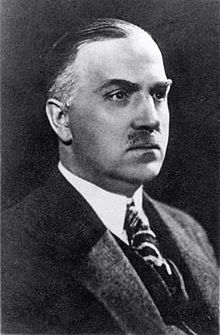Jan Czochralski
| Jan Czochralski | |
|---|---|
 |
|
| Born |
23 October 1885 Exin, German Empire |
| Died | 22 April 1953 (aged 67) Poznań, Poland |
| Citizenship | Polish and German |
| Nationality | Polish |
| Fields | Chemistry, Metallurgy |
| Institutions | Warsaw University of Technology |
| Alma mater | Charlottenburg Polytechnic in Berlin |
| Known for | Czochralski process |
| Spouse | Marguerite Haase |
Jan Czochralski (pronounced as YAN chokh-RAHL-skee, Polish pronunciation: ['jan t͡ʂɔ'xralskʲi]; 23 October 1885 – 22 April 1953) was a Polish chemist who invented the Czochralski process, which is used for growing single crystals and in the production of semiconductor wafers. He is the most cited Polish scholar. He was also known for extraordinary physical strength.
Czochralski was born in what was then Exin in the Prussian Province of Pomerania, German Empire (now Kcynia, Poland). Around 1900 he moved to Berlin, where he worked at a pharmacy. He was educated at Charlottenburg Polytechnic in Berlin, where he specialized in metal chemistry. Czochralski began working as an engineer for Allgemeine Elektrizitäts Gesellschaft (AEG) in 1907.
He discovered the Czochralski method in 1916, when he accidentally dipped his pen into a crucible of molten tin rather than his inkwell. He immediately pulled his pen out to discover that a thin thread of solidified metal was hanging from the nib. The nib was replaced by a capillary, and Czochralski verified that the crystallized metal was a single crystal. Czochralski's experiments produced single crystals a millimeter in diameter and up to 150 centimeters long. He published a paper on his discovery in 1918 in the Zeitschrift für Physikalische Chemie, a German chemistry journal, under the title "Ein neues Verfahren zur Messung der Kristallisationsgeschwindigkeit der Metalle" [A new method for the measurement of the crystallization rate of metals], since the method was at that time used for measuring the crystallization rate of metals such as tin, zinc and lead. In 1950, Americans Gordon K. Teal and J.B. Little from Bell Labs would use the method to grow single germanium crystals, leading to its use in semiconductor production.
...
Wikipedia
